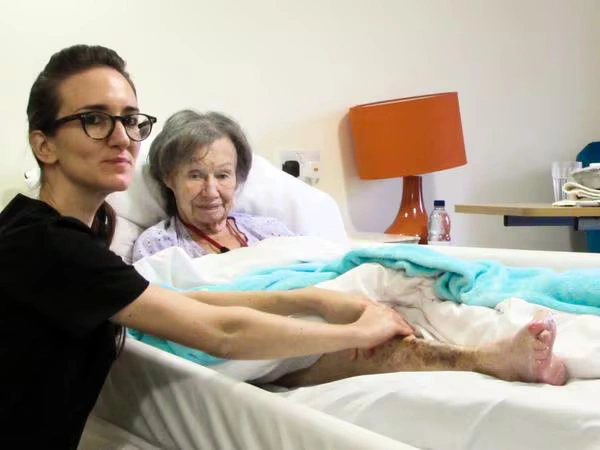Jo Murch knows the benefits massage can have on achy and arthritic joints. As a massage therapist Jo set up Massage And Me. Having led a stressful life as a commuter in London, Jo discovered the relaxing qualities of massage therapy and decided to become a masseuse herself. Now she works with a variety of clients many of whom are care home residents with a deep appreciation of massage therapy’s ability to alleviate the symptoms of arthritis.
Massage is primarily for…
muscles. But if you have painful or arthritic joints then helping the muscles around them can reap huge rewards. By looking after the muscles around a joint, they in turn help look after the joint.
By warming up muscles…
you can greatly decrease joint stiffness. We do this not by directly massaging the painful area – although we can do this if the client wants – but by massaging the muscles around the joint. This can help reduce muscles spasms. Massage helps improve circulation generally, it assists in the removal of toxins from muscles and brings nutrients and oxygen to the massaged area. This is especially true of some of the elderly clients I work with who don’t get to move as much as their bodies need to. Massage encourages a relaxation response in the brain, decreasing our levels of cortisol (a stress hormone). It can also increase levels of serotonin in the body – a neurochemical which regulates our mood and enhances feelings of relaxation.

When muscles tense…
they form knots and adhesions. It’s like a kink in a hosepipe; suddenly there is a significant reduction blood flow to that muscle and the surrounding area. Massaging these knots allows the nutrients to re-enter the muscles, once the muscle is no longer starved of fresh blood. I can feel beneath the skin to determine where the knots are. That area of tension will be a build-up of toxins like lactic acid. When you work out those knots – through deep tissue or gradually over time – blood will return to the area and remove the build-up of toxins and acids while bringing in new nutrients to support the area. Over time you’ll find you can regain a range of motion that allows you to move the muscle and joint more freely.
Many people with arthritis…
know that heat and warmth can really help their aching joints. Massage involves heat. I often tell my patients before I go and see them to put a hot water bottle or a heat pack on the joint or area that is causing them pain. That loosens the joint up and lets me come in and really work with the muscle in a more supple way.
When you’re cold…
your muscles tense. For someone with arthritis this is even more important. You have to work the muscles up gradually before you can apply the pressure that will achieve the maximum effect. Think of it like an athlete. They do not just start running. They warm their muscles up through stretching. In doing so, they’re getting the circulation in there, they’re getting the muscles moving in their early phases. This is how massage can help; it gets those muscles warm, increases blood flow to our muscles and then gradually begins to work them in order to regain motion.
A massage therapist is…
never going to hurt you. I have several clients with osteoarthritis. At first they say they’d rather I not massage that area because they’re concerned about the pain and damage it might do. But by explaining to them that it can help, and by working together, they can communicate with me to make sure they’re not in pain when we work. We’ve started off gently, with low impact, light pressure so they can feel it’s not painful and I’m not going to suddenly yank their joints out of place. We’ve built up gradually and they’re beginning to see the benefits. One client in particular who has arthritis around her hip has really appreciated the improvement to her pain and mobility.

Client-therapist communication…
is key. I always encourage my clients to talk to me. If they’ve got an area that is sensitive I’ll be sure to go lightly there. That communication is as much up to the client as it is the therapist. It’s a therapist’s job to make sure they are creating a comfortable environment for the client so that they feel free to communicate exactly what they want from the session.
I always encourage my clients…
to seek medical advice from their doctor before we start if they are in any way apprehensive about having a massage. If their doctor tells them it might help then that can offer the necessary peace of mind to give the client confidence to try it.
If a client has arthritis…
you can tell very quickly. It can feel bubbly and crackly under the skin. It’s often those with arthritis who want to see me every week. I work with one lady at the care home, she’s 98. Her knees are often in a lot of pain from arthritis so she’ll be desperate to see me to get them working, moving and get some relief from the pain and stiffness she’s experiencing.
One of my clients is a…
tough cookie. I’ve been seeing her over the past six weeks. To begin with she said that it helped when she had the massage but the pain came back. The other day we started and I could see she was immediately more relaxed than when we first started working together. She is seeing the benefits of it and is now a lovely patient to work with because she knows we’re both working towards the same goal: helping her move freely without pain.
You can find out more about Jo and Massage And Me on her WEBSITE as well as following her on Facebook.




